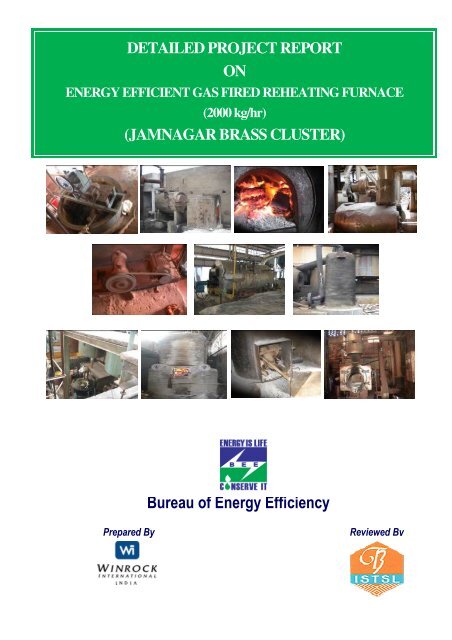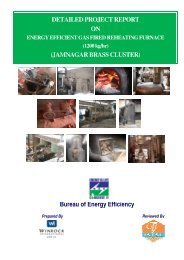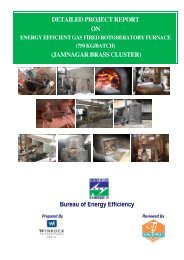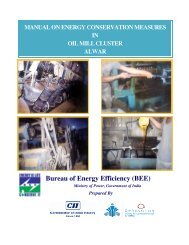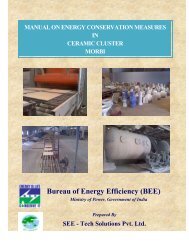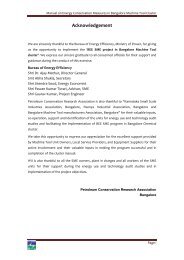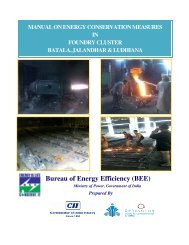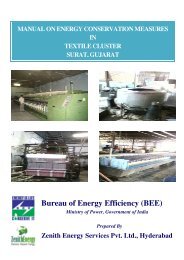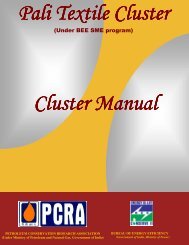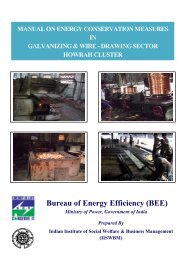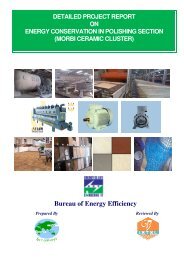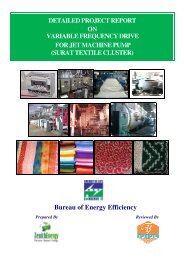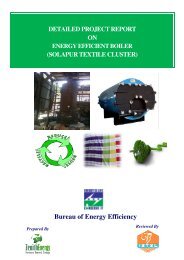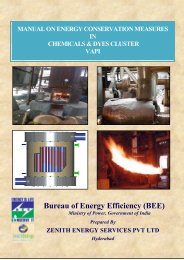DPR on Energy Efficient Gas Fired Reheating ... - Sameeeksha
DPR on Energy Efficient Gas Fired Reheating ... - Sameeeksha
DPR on Energy Efficient Gas Fired Reheating ... - Sameeeksha
You also want an ePaper? Increase the reach of your titles
YUMPU automatically turns print PDFs into web optimized ePapers that Google loves.
DETAILED PROJECT REPORT<br />
ENERGY EFFICIENT GAS FIRED REHEATING FURNACE<br />
(JAMNAGAR BRASS CLUSTER)<br />
Prepared By<br />
ON<br />
(2000 kg/hr)<br />
Bureau of <strong>Energy</strong> Efficiency<br />
Reviewed By
ENERGY EFFICIENT GAS FIRED REHEATING FURNACE<br />
(2000 kg/hr)<br />
(JAMNAGAR BRASS CLUSTER)
BEE, 2010<br />
Detailed Project Report <strong>on</strong> <strong>Energy</strong> <strong>Efficient</strong> <strong>Gas</strong> <strong>Fired</strong> <strong>Reheating</strong> Furnace<br />
(2000 kg/hr)<br />
For more informati<strong>on</strong><br />
Brass SME Cluster, Jamnagar, Gujarat (India)<br />
New Delhi: Bureau of <strong>Energy</strong> Efficiency;<br />
Detail Project Report No.: JAM/BRS/EGF/12<br />
Bureau of <strong>Energy</strong> Efficiency (BEE)<br />
(Ministry of Power, Government of India)<br />
4 th Floor, Sewa Bhawan<br />
R. K. Puram, New Delhi – 110066<br />
Teleph<strong>on</strong>e +91-11-26179699<br />
Fax +91-11-26178352<br />
Websites: www.bee-india.nic.in<br />
Email: jsood@beenet.in/ pktiwari@beenet.in
Acknowledgement<br />
We are sincerely thankful to the Bureau of <strong>Energy</strong> Efficiency, Ministry of Power, for giving<br />
us the opportunity to implement the ‘BEE SME project in “Jamnagar Brass Cluster”. We<br />
express our sincere gratitude to all c<strong>on</strong>cerned officials for their support and guidance<br />
during the c<strong>on</strong>duct of this exercise.<br />
Dr. Ajay Mathur, Director General, BEE<br />
Smt. Abha Shukla, Secretary, BEE<br />
Shri Jitendra Sood, <strong>Energy</strong> Ec<strong>on</strong>omist, BEE<br />
Shri Pawan Kumar Tiwari, Advisor (SME), BEE<br />
Shri Rajeev Yadav, Project Ec<strong>on</strong>omist, BEE<br />
Winrock Internati<strong>on</strong>al India(WII) is also thankful to “The Jamnagar Factory Owners<br />
Associati<strong>on</strong>, Jamnagar” for their valuable inputs, co-operati<strong>on</strong>, support and identificati<strong>on</strong><br />
of the units for energy use and technology audit studies and facilitating the implementati<strong>on</strong><br />
of BEE SME program in Jamnagar Brass Cluster.<br />
We take this opportunity to express our appreciati<strong>on</strong> for the excellent support provided by<br />
Brass Unit Owners, Local Service Providers, and Equipment Suppliers for their active<br />
involvement and their valuable inputs in making the program successful and in completi<strong>on</strong><br />
of the Detailed Project Report (<str<strong>on</strong>g>DPR</str<strong>on</strong>g>).<br />
WII is also thankful to all the SME owners, plant in charges and all workers of the SME<br />
units for their support during the energy use and technology audit studies and in<br />
implementati<strong>on</strong> of the project objectives.<br />
Winrock Internati<strong>on</strong>al India<br />
New Delhi
C<strong>on</strong>tents<br />
List of Annexure vii<br />
List of Tables vii<br />
List of Figures viii<br />
List of Abbreviati<strong>on</strong> viii<br />
Executive summary ix<br />
About BEE’S SME program x<br />
1 INTRODUCTION ................................................................................................ 1<br />
1.1 Brief introducti<strong>on</strong> about cluster ............................................................................ 1<br />
1.1.1 Existing producti<strong>on</strong> process ................................................................................ 2<br />
1.2 <strong>Energy</strong> Performance in Jamnagar Brass cluster ................................................. 3<br />
1.2.1 Specific energy c<strong>on</strong>sumpti<strong>on</strong> .............................................................................. 3<br />
1.3 Identificati<strong>on</strong> of existing technology/ equipment .................................................. 4<br />
1.3.1 Descripti<strong>on</strong> of equipment .................................................................................... 4<br />
1.3.2 Technical gap in c<strong>on</strong>venti<strong>on</strong>al oil fired reheating furnace .................................... 5<br />
1.3.3 Specificati<strong>on</strong> of exisitng furnace ......................................................................... 6<br />
1.3.4 Role in the process ............................................................................................ 6<br />
1.3.5 Need for up gradati<strong>on</strong> of existing equipment ...................................................... 6<br />
1.4 Baseline energy c<strong>on</strong>sumpti<strong>on</strong> of existing equipment .......................................... 7<br />
1.4.1 Design and operating parameters ...................................................................... 7<br />
1.4.2 Specific fuel c<strong>on</strong>sumpti<strong>on</strong> .................................................................................. 7<br />
1.4.3 <strong>Energy</strong> audit methodology ................................................................................. 8<br />
1.5 Barriers in adopti<strong>on</strong> of proposed technology/equipment ...................................... 8<br />
1.5.1 Technological Barrier .......................................................................................... 9<br />
1.5.2 Financial Barrier .................................................................................................. 9<br />
1.5.3 Skilled manpower ..............................................................................................10<br />
2 EQUIPMENT OPTION FOR ENERGY EFFICIENCY IMPROVEMENT .............11<br />
2.1 Descripti<strong>on</strong> of proposed equipment ....................................................................11
2.1.1 Comparis<strong>on</strong> of c<strong>on</strong>venti<strong>on</strong>al with new rehating furnace .....................................11<br />
2.1.2 Suitability over existing system ..........................................................................12<br />
2.1.4 Technical specificati<strong>on</strong>s .....................................................................................12<br />
2.1.5 Superiority over existing system ........................................................................12<br />
2.1.6 Availability of proposed equipment .....................................................................13<br />
2.1.7 Equipment providers ..........................................................................................13<br />
2.1.8 Terms and c<strong>on</strong>diti<strong>on</strong>s in sales of <strong>Energy</strong> efficient reheating furnace ..................13<br />
2.2 Process down time during implementati<strong>on</strong> .........................................................14<br />
2.3 Suitable unit for proposed equipment .................................................................14<br />
3 ECONOMIC BENEFITS OF NEW EQUIPMENT ...............................................15<br />
3.1 <strong>Energy</strong> & m<strong>on</strong>etary benefits ...............................................................................15<br />
3.1.1 Fuel Saving ........................................................................................................15<br />
3.1.2 Electricity saving ................................................................................................15<br />
3.1.2 M<strong>on</strong>etary benefit ................................................................................................15<br />
3.2 Envir<strong>on</strong>mental benefits .......................................................................................15<br />
3.2.1 Reducti<strong>on</strong> in fuel c<strong>on</strong>sumpti<strong>on</strong> ...........................................................................15<br />
3.2.2 GHG emissi<strong>on</strong> reducti<strong>on</strong>s ..................................................................................15<br />
3.2.2 CDMability of the project ....................................................................................16<br />
3.3 SOCIAL BENEFITS .................................................................................................16<br />
3.3.1 Impact <strong>on</strong> working envir<strong>on</strong>ment .........................................................................16<br />
3.3.2 Impact <strong>on</strong> manpower skills .................................................................................16<br />
3.3.3 Impact <strong>on</strong> wages/emoluments ...........................................................................16<br />
3.4 Other benefits (If any) ........................................................................................16<br />
3.4.1 Productivity improvements .................................................................................16<br />
3.4.2 Quality improvements ........................................................................................16<br />
3.4.3 Easy operati<strong>on</strong>& maintenance ...........................................................................17<br />
4 ECONOMICS & IMPLEMENTATION OF NEW SYSTEM ..................................18<br />
4.1 Cost of project implementati<strong>on</strong> ...........................................................................18
4.1.1 Equipment cost ..................................................................................................18<br />
4.1.2 Other cost ..........................................................................................................18<br />
4.2 Arrangement of funds .........................................................................................18<br />
4.2.1 Entrepreneurs c<strong>on</strong>tributi<strong>on</strong> .................................................................................18<br />
4.2.2 Loan amount ......................................................................................................18<br />
4.2.3 Terms & c<strong>on</strong>diti<strong>on</strong>s of loan.................................................................................19<br />
4.3 Financial Indicators ............................................................................................19<br />
4.3.1 Cash flow analysis .............................................................................................19<br />
4.3.2 Simple payback period .......................................................................................19<br />
4.3.3 Net Preset Value (NPV) .....................................................................................19<br />
4.3.4 Internal rate of return (IRR) ................................................................................19<br />
4.3.5 Return <strong>on</strong> Investment (ROI) ...............................................................................20<br />
4.4 Sensitivity analysis .............................................................................................20<br />
4.5 Procurement and implementati<strong>on</strong> schedule........................................................20
List of Annexure<br />
Annexure-1 <strong>Energy</strong> audit reports of c<strong>on</strong>venti<strong>on</strong>al reheating furnace .................................. 1<br />
Annexure 2 Process flow diagram ..................................................................................... 3<br />
Annexure-3 Detail technical assessment report ................................................................. 4<br />
Annexure-5 Detailed cash flow evaluati<strong>on</strong>s ....................................................................... 6<br />
Annexure-6 Details of procurement and implementati<strong>on</strong> plan ...........................................10<br />
Annexure-7 Details of equipment and service providers ...................................................11<br />
Annexure 8 Quotati<strong>on</strong>s of energy efficient reheating furnace ............................................12<br />
List of Tables<br />
Table 1.1 Annual <strong>Energy</strong> c<strong>on</strong>sumpti<strong>on</strong> and producti<strong>on</strong> ....... Error! Bookmark not defined.<br />
Table 1.2 Specific energy c<strong>on</strong>sumpti<strong>on</strong> of a typical unit .................................................... 3<br />
Table 1.3 Specificati<strong>on</strong> of existing furnace ........................................................................ 6<br />
Table 2.1 Comparis<strong>on</strong> of c<strong>on</strong>venti<strong>on</strong>al equipment and proposed equipment ....................11<br />
Table 2.2 Technical specificati<strong>on</strong>s ....................................................................................12<br />
Table 4.1 Details of proposed equipment installati<strong>on</strong> cost ................................................18<br />
Table 4.2 Financial parameters of energy efficient furnace .............................................20<br />
Table 4.3 Sensitivity analysis .........................................................................................20<br />
vii
List of Figures<br />
Figure 1.1: Process flow chart ........................................................................................... 2<br />
Figure 1.2: Percentage of energy c<strong>on</strong>sumpti<strong>on</strong> in different type of unit ............................. 3<br />
Figure1.3 Existing furnace operati<strong>on</strong>s ............................................................................... 4<br />
Figure1.4: <strong>Energy</strong> audit methodology ................................................................................ 8<br />
Figure2.1: <strong>Energy</strong> efficient reheating furnace ...................................................................11<br />
List of Abbreviati<strong>on</strong>s<br />
MT Metric T<strong>on</strong>ne<br />
kWh kilo Watt Hour<br />
GoI Government Of India<br />
MoMSME Ministry of Micro Small and Medium Enterprises<br />
GHG Green House <strong>Gas</strong><br />
BEE Bureau of <strong>Energy</strong> Efficiency<br />
<str<strong>on</strong>g>DPR</str<strong>on</strong>g> Detailed Project Report<br />
O&M Operati<strong>on</strong>al & Maintenance<br />
NPV Net Present Values<br />
ROI Return <strong>on</strong> Investment<br />
IRR Internal Rate Of Return<br />
DSCR Debt Service Coverage Ratio<br />
PBT Profit Before Tax<br />
PAT Profit After Tax<br />
ID Induced Draft<br />
FD Forced Draft<br />
DBT Dry Bulb Temperature<br />
SIDBI Small Industries Development Bank of India<br />
viii
EXECUTIVE SUMMARY<br />
Winrock Internati<strong>on</strong>al India is executing BEE-SME program in Jamnagar Brass Cluster,<br />
supported by Bureau of <strong>Energy</strong> Efficiency (BEE) with an overall objective of improving the<br />
energy efficiency in cluster units.<br />
Jamnagar is known as the brass city of India, it has been an important industrial centre<br />
since l<strong>on</strong>g for brass related parts. All the units in Jamnagar Brass cluster had been<br />
operating in traditi<strong>on</strong>al c<strong>on</strong>diti<strong>on</strong>s and most of equipments/utilities using in cluster were<br />
procured from the local suppliers. They are making the equipments <strong>on</strong> their traditi<strong>on</strong>al<br />
expertise, which had remained unchanged over the years. Hence this cluster was chosen<br />
for energy efficiency improvements by implementing energy efficient technologies, so as<br />
to facilitate maximum replicati<strong>on</strong> in other brass clusters in India.<br />
Major energy sources being used in manufacturing of Brass parts in Jamnagar Brass<br />
cluster are electricity and fuels such as Coal, Furnace Oil and Liquid petroleum gas. This<br />
depends <strong>on</strong> applicati<strong>on</strong> of technology, process requirement, availability, and ec<strong>on</strong>omic<br />
and safety point of view. The two forms of energy being used in manufacturing of Brass<br />
parts in typical Brass unit are electrical energy and thermal energy. Electrical energy is<br />
being used in melting of Brass in inducti<strong>on</strong> furnaces, operati<strong>on</strong> of electrical utilities and<br />
thermal energy is being used in Brass melting operati<strong>on</strong>.<br />
Functi<strong>on</strong> of the reheating furnace in brass industries is reheating of raw material. During<br />
energy use and technology audit studies in various brass industry in Jamnagar brass<br />
cluster, it was observed that most of the brass units are using inefficient oil fired reheating<br />
furnace for reheating the brass billets and it is found that the efficiencies of existing<br />
reheating furnace is low.<br />
Implementati<strong>on</strong> of proposed energy efficient <strong>Gas</strong> fired reheating furnace equipped with<br />
waste heat recovery system having efficiency more that existing furnace would save<br />
energy and replace total 148120 litre of oil c<strong>on</strong>sumpti<strong>on</strong> per year.<br />
This <str<strong>on</strong>g>DPR</str<strong>on</strong>g> highlights the details of the study c<strong>on</strong>ducted for assessing the potential for<br />
replacement of c<strong>on</strong>venti<strong>on</strong>al oil fired reheating furnace by new energy efficient gas fired<br />
reheating furnace , possible energy saving, and its m<strong>on</strong>etary benefit, availability of the<br />
technologies/design, local service providers, technical features & proposed equipment<br />
specificati<strong>on</strong>s, various barriers in implementati<strong>on</strong>, envir<strong>on</strong>mental aspects, estimated GHG<br />
reducti<strong>on</strong>s, capital cost, financial analysis, sensitivity analysis for three different scenarios<br />
and schedule of Project Implementati<strong>on</strong>.<br />
ix
This bankable <str<strong>on</strong>g>DPR</str<strong>on</strong>g> also found eligible for subsidy scheme of MoMSME for “Technology<br />
and Quality Upgradati<strong>on</strong> Support to Micro, Small and Medium Enterprises” under “Nati<strong>on</strong>al<br />
Manufacturing and Competitiveness Programme”. The key indicators of the <str<strong>on</strong>g>DPR</str<strong>on</strong>g> including<br />
the Project cost, debt equity ratio, m<strong>on</strong>etary benefit and other necessary parameters are<br />
given in table:<br />
S.No Particular Unit Value<br />
1 Project cost `(in Lakh) 18.70<br />
2 Furnace oil c<strong>on</strong>sumpti<strong>on</strong> in base case litre/year 148120<br />
3 <strong>Gas</strong> c<strong>on</strong>sumpti<strong>on</strong> in proposed case Nm 3 /year 104000<br />
4 M<strong>on</strong>etary benefit due to fuel change `(in Lakh) 16.33<br />
5 Debit equity ratio Ratio 3:1<br />
6 Simple payback period years 1.15<br />
7 NPV `(in Lakh) 42.29<br />
8 IRR % 67.65<br />
9 ROI % 28.11<br />
10 DSCR Ratio 3.59<br />
11 Process down time Days 7<br />
12 CO2 reducti<strong>on</strong> T<strong>on</strong>s/year 253<br />
The projected profitability and cash flow statements indicate that the proposed<br />
project implementati<strong>on</strong> i.e. energy efficient gas fired reheating furnace with existing<br />
oil fired reheating furnace will be financially viable and technically feasible.<br />
x
ABOUT BEE’S SME PROGRAM<br />
Bureau of <strong>Energy</strong> Efficiency (BEE) is implementing a BEE-SME Programme to improve<br />
the energy performance in 25 selected SMEs clusters. Jamnagar Brass Cluster is <strong>on</strong>e of<br />
them. The BEE’s SME Programme intends to enhance the energy efficiency awareness<br />
by funding/subsidizing need based studies in SME clusters and giving energy<br />
c<strong>on</strong>servati<strong>on</strong> recommendati<strong>on</strong>s. For addressing the specific problems of these SMEs and<br />
enhancing energy efficiency in the clusters, BEE will be focusing <strong>on</strong> energy efficiency,<br />
energy c<strong>on</strong>servati<strong>on</strong> and technology up gradati<strong>on</strong> through studies and pilot projects in<br />
these SMEs clusters.<br />
Major activities in the BEE -SME program are furnished below:<br />
Activity 1: <strong>Energy</strong> use and technology audit<br />
The energy use technology studies would provide informati<strong>on</strong> <strong>on</strong> technology status, best<br />
operating practices, gaps in skills and knowledge <strong>on</strong> energy c<strong>on</strong>servati<strong>on</strong> opportunities,<br />
energy saving potential and new energy efficient technologies, etc for each of the sub<br />
sector in SMEs.<br />
Activity 2: Capacity building of stake holders in cluster <strong>on</strong> energy efficiency<br />
In most of the cases SME entrepreneurs are dependent <strong>on</strong> the locally available<br />
technologies, service providers for various reas<strong>on</strong>s. To address this issue BEE has also<br />
undertaken capacity building of local service providers and entrepreneurs/ managers of<br />
SMEs <strong>on</strong> energy efficiency improvement in their units as well as clusters. The local service<br />
providers will be trained in order to be able to provide the local services in setting of<br />
energy efficiency projects in the clusters<br />
Activity 3: Implementati<strong>on</strong> of energy efficiency measures<br />
To implement the technology up gradati<strong>on</strong> projects in clusters, BEE has proposed to<br />
prepare the technology based detailed project reports (<str<strong>on</strong>g>DPR</str<strong>on</strong>g>s) for a minimum of five<br />
technologies in three capacities for each technology.<br />
Activity 4: Facilitati<strong>on</strong> of innovative financing mechanisms for implementati<strong>on</strong> of<br />
energy efficiency projects<br />
The objective of this activity is to facilitate the uptake of energy efficiency measures<br />
through innovative financing mechanisms without creating market distorti<strong>on</strong><br />
xi
1 INTRODUCTION<br />
1.1 Brief introducti<strong>on</strong> about Cluster<br />
<strong>Energy</strong> <strong>Efficient</strong> <strong>Gas</strong> <strong>Fired</strong> <strong>Reheating</strong> Furnace (2000 kg/hr)<br />
Jamnagar, known as the brass city of India, has been an important industrial centre since<br />
l<strong>on</strong>g for brass related parts. Jamnagar is inhabited by a various types of brass related work<br />
units which include Brass foundry; Brass parts manufacturing, Electroplating and Extrusi<strong>on</strong><br />
units. There are about 3500 brass related units al<strong>on</strong>e in Jamnagar. Majority of these Brass<br />
units in Jamnagar are in operati<strong>on</strong> since last 20 years. All these units are located in pockets<br />
of Shankartekri, MP Shah Udyognagar, Patel col<strong>on</strong>y and Dared areas.<br />
Jamnagar Brass cluster like many other clusters was in dire-straits with regard to the energy<br />
efficiency and c<strong>on</strong>servati<strong>on</strong>. In almost all units, whether big or small, there had been no<br />
c<strong>on</strong>scious effort to take up energy c<strong>on</strong>servati<strong>on</strong> and energy efficiency measures as a part of<br />
day to day operati<strong>on</strong>s. Many a times, the small scale entrepreneur was not even aware of<br />
measures that could bring down the percentage energy cost, which automatically brings<br />
down the manufacturing cost. Some of the bigger units had experimented with few<br />
parameters to improve energy efficiency in the units, but the results and outcome was<br />
c<strong>on</strong>fined to them <strong>on</strong>ly. All the units in Jamnagar Brass cluster had been operating in<br />
traditi<strong>on</strong>al c<strong>on</strong>diti<strong>on</strong>s and most of equipments/utilities using in cluster were procured from the<br />
local suppliers. They are making the equipments <strong>on</strong> their traditi<strong>on</strong>al expertise, which had<br />
remained unchanged over the years.<br />
Till now there has been very little focus <strong>on</strong> energy c<strong>on</strong>servati<strong>on</strong> activities in the units. Also,<br />
there have been no c<strong>on</strong>crete external interventi<strong>on</strong>s as well to help the small units come<br />
out of their shell and rise up to the necessary energy efficiency benchmarks. The raw<br />
material requirement of the Jamnagar Brass cluster is met mainly from the following three<br />
sources:<br />
Old brass, copper and br<strong>on</strong>ze utensils<br />
Imported brass scrap and h<strong>on</strong>ey<br />
Brass scrap from ship breaking yard<br />
Apart from the Brass scrap; copper, zinc, led, other metal alloys and clay etc are also used<br />
as raw material depends <strong>on</strong> the final product requirement<br />
Majority of the raw material requirement in Jamnagar Brass cluster is met through imports.<br />
The countries from which it is imported are USA, Singapore, Gulf and European countries.<br />
The imported raw material is available mainly in three forms i.e. H<strong>on</strong>ey scrap, Dross of<br />
brass & Pale in the form of strips.<br />
1
1.1.1 Existing producti<strong>on</strong> process<br />
<strong>Energy</strong> <strong>Efficient</strong> <strong>Gas</strong> <strong>Fired</strong> <strong>Reheating</strong> Furnace (2000 kg/hr)<br />
The producti<strong>on</strong> process menti<strong>on</strong>ed in the below chart is almost similar to most of brass<br />
part manufacturing units in the Jamnagar brass cluster. However, depending <strong>on</strong> the final<br />
product, quality of final product manufacturing unit and raw material properties, stated<br />
process flow is altered to suit the requirement of industry.<br />
Figure 1.1: Process flow chart<br />
2
1.2 <strong>Energy</strong> Performance in Jamnagar Brass cluster<br />
<strong>Energy</strong> <strong>Efficient</strong> <strong>Gas</strong> <strong>Fired</strong> <strong>Reheating</strong> Furnace (2000 kg/hr)<br />
Major energy sources being used in manufacturing of Brass parts in Jamnagar Brass<br />
cluster are electricity and fuels such as Coal, Furnace Oil and Liquid petroleum gas. This<br />
depends <strong>on</strong> applicati<strong>on</strong> of technology, process requirement, availability, and ec<strong>on</strong>omic<br />
and safety point of view. The two forms of energy being used in manufacturing of Brass<br />
parts in typical Brass unit are electrical energy and thermal energy. Electrical energy is<br />
being used in melting of Brass in inducti<strong>on</strong> furnaces, operati<strong>on</strong> of electrical utilities and<br />
thermal energy is being used in Brass melting operati<strong>on</strong>.<br />
<strong>Energy</strong> c<strong>on</strong>sumpti<strong>on</strong> (thermal energy & electrical energy) in Brass unit depends <strong>on</strong> type of<br />
unit and final product manufacturing in unit. Annual electrical energy and thermal energy<br />
c<strong>on</strong>sumpti<strong>on</strong> in typical Brass foundry, Extrusi<strong>on</strong> unit, Machining and Electroplating unit is<br />
presented in below bar chart<br />
Figure 1.2: Percentage of energy c<strong>on</strong>sumpti<strong>on</strong> in different type of unit<br />
1.2.1 Specific energy c<strong>on</strong>sumpti<strong>on</strong><br />
Specific electrical and thermal energy c<strong>on</strong>sumpti<strong>on</strong> in brass unit is varying <strong>on</strong> the final<br />
product manufactured in that unit. Specific energy c<strong>on</strong>sumpti<strong>on</strong> specific energy cost in<br />
different brass unit is shown in Table 1.1 & Table 1.2 below:<br />
Table 1.1 Specific energy c<strong>on</strong>sumpti<strong>on</strong> in various brass units<br />
S.No. Type of units Unit Value<br />
1 Brass foundry unit kCal/kg of brass rod 1013-1057<br />
2 Brass extrusi<strong>on</strong> unit kCal/kg of brass rod 1037-1186<br />
3 Brass machining unit kCal/kg of final product 473.04<br />
4 Brass electroplating kCal/kg of final product 875.21<br />
3
Table 1.2 Specific energy cost in various brass units<br />
1.3 Identificati<strong>on</strong> of existing technology/ equipment<br />
1.3.1 Descripti<strong>on</strong> of equipment<br />
<strong>Energy</strong> <strong>Efficient</strong> <strong>Gas</strong> <strong>Fired</strong> <strong>Reheating</strong> Furnace (2000 kg/hr)<br />
During energy use and technology audit studies in various brass industry in Jamnagar<br />
brass cluster, it was observed that most of the brass units are using inefficient reheating<br />
furnace for reheating the brass billets and it is found that the efficiencies of existing<br />
reheating furnace is low. Performances of various reheating furnaces in Jamnagar Brass<br />
units are evaluated and analyze the quantum of various losses in <strong>Reheating</strong> furnace were<br />
analyzed.<br />
.<br />
S.No. Type of units Unit Value<br />
1 Brass foundry unit `/kg of brass rod 3.17-3.02<br />
2 Brass extrusi<strong>on</strong> unit `/kg of brass rod 5.64-5.194<br />
3 Brass machining unit `/kg of final product 3.24<br />
4 Brass electroplating unit `/kg of final product 5.99<br />
Figure1.3 C<strong>on</strong>venti<strong>on</strong>al oil fired furnace operati<strong>on</strong>s<br />
From energy use and technology gap audit studies in various brass industries in<br />
Jamnagar brass cluster, below menti<strong>on</strong>ed things are identified:<br />
• <strong>Energy</strong> efficiency improvement opportunities<br />
4
<strong>Energy</strong> <strong>Efficient</strong> <strong>Gas</strong> <strong>Fired</strong> <strong>Reheating</strong> Furnace (2000 kg/hr)<br />
• Envir<strong>on</strong>ment and safety improvement of workers<br />
• Design flaws in the c<strong>on</strong>venti<strong>on</strong>al oil fired reheating furnace<br />
• Operati<strong>on</strong>al & maintenance practices in c<strong>on</strong>venti<strong>on</strong>al reheating furnace<br />
1.3.2 Technical gap in c<strong>on</strong>venti<strong>on</strong>al oil fired reheating furnace<br />
Technology gaps/design flaws in c<strong>on</strong>venti<strong>on</strong>al oil fired reheating furnace system are<br />
identified and described below in detail<br />
Air-Fuel Ratios<br />
From energy use and technology studies it was observed that, air fuel ratio is not proper<br />
maintained. This reduces the furnace efficiency by 3-5%.<br />
Locati<strong>on</strong> of Chimney<br />
In majority of industries, chimney is located at centre of reheating furnaces; this causes<br />
the poor heat transfer between flue gasses and charge; this automatically leads to poor<br />
heat transfer efficiency between flue gas and reheating material.<br />
Waste Heat Recovery System<br />
This is the <strong>on</strong>e of the area where major amount of heat energy is lost; in majority of the<br />
units is not installed waste heat recovery system to recover the heat from flue gasses. In a<br />
few cases it was observed that efficiency of existing waste heat recovery system is poor.<br />
Around 35% of heat input energy to reheating furnace is lost in the flue gasses.<br />
Preheating of Charge and Combusti<strong>on</strong> Air:<br />
In majority of the systems it was observed that, there is no system to preheat the charge<br />
and air.<br />
Insulating Material<br />
Furnace lining of the existing furnace was d<strong>on</strong>e with the locally available firebricks. The<br />
firebricks with low alumina c<strong>on</strong>tent tend to get worn out in a short durati<strong>on</strong>. Also, the<br />
insulati<strong>on</strong> required for plugging heat loss through the furnace was usually d<strong>on</strong>e with locally<br />
available red bricks, which do not serve the purpose of insulati<strong>on</strong>.<br />
Burner<br />
Majority of units are using locally fabricated burners for the combusti<strong>on</strong> of fuel oil. These<br />
burners were either a far copy of a properly designed burner or sometimes substandard<br />
and locally designed. Many a times, oil could be seen leaking from the burner joints. Same<br />
types of burners were used for a large range of fuel flow rates.<br />
5
Selecti<strong>on</strong> and Size of Blower System:<br />
<strong>Energy</strong> <strong>Efficient</strong> <strong>Gas</strong> <strong>Fired</strong> <strong>Reheating</strong> Furnace (2000 kg/hr)<br />
A proper capacity blower is necessary for combusti<strong>on</strong> air to be delivered at correct<br />
pressure and in appropriate volume. The existing blowers in the majority of the units are<br />
either locally fabricated without any proper design parameters or are under/over- sized<br />
without any c<strong>on</strong>siderati<strong>on</strong> for correct air pressure.<br />
Inadequate Sizing of Heating and Pumping Unit:<br />
In majority of the units it was observed that heating and pumping system are not designed<br />
properly. This is mainly due to lack of awareness about the standard oil temperature and<br />
pressure at the combusti<strong>on</strong> stage and the benefits thereof.<br />
1.3.3 Specificati<strong>on</strong> of exisitng furnace<br />
Detailed specificati<strong>on</strong> of existing oil fired reheating furnace is furnished in Table 1.3 below:<br />
Table 1.3 Specificati<strong>on</strong> of existing furnace<br />
S. No Details Units Value<br />
1 Capacity TPH 2.0<br />
2 Fuel used Furnace oil<br />
3 Operati<strong>on</strong>al hours Hrs/year 2000<br />
4 Furnace depth Inches 300<br />
5 Furnace width Inches 28<br />
6 Furnace height Inches 40<br />
1.3.4 Role in the process<br />
Functi<strong>on</strong> of the reheating furnace in brass industries is to reheat the raw material.<br />
<strong>Reheating</strong> is <strong>on</strong>e of the major energy and time c<strong>on</strong>suming process in the overall<br />
manufacturing process in brass industry. Apart from the energy and time, final product<br />
quality will also depend <strong>on</strong> time and temperature of reheating of raw material.<br />
1.3.5 Need for up gradati<strong>on</strong> of existing equipment<br />
From the above secti<strong>on</strong>s it is clear that reheating cost is <strong>on</strong>e of the major costs in the<br />
overall brass manufacturing process, in typical brass manufacturing industry, which comes<br />
out to be ` 1.036 per kg. This is approximately 20% of overall energy cost i.e. ` 5.2 - 5.6<br />
per kg.<br />
6
<strong>Energy</strong> <strong>Efficient</strong> <strong>Gas</strong> <strong>Fired</strong> <strong>Reheating</strong> Furnace (2000 kg/hr)<br />
The efficiency of the existing installed c<strong>on</strong>venti<strong>on</strong>al reheating furnace is 18.73 % <strong>on</strong>ly.<br />
Existing reheating furnaces being used in majority of the industries are of very primitive<br />
design; have poor preheating of charge, they do not have waste heat recovery system and<br />
poor heat transfer efficiency between hot flue gasses & billets. All these things will lead to<br />
increase in energy c<strong>on</strong>sumpti<strong>on</strong> in reheating furnace.<br />
Advantages of replacing the c<strong>on</strong>venti<strong>on</strong>al furnace with <strong>Energy</strong> <strong>Efficient</strong> furnace are:<br />
• Improved product quality<br />
• Saving in reheating time - it automatically leads to energy savings<br />
• Improved working envir<strong>on</strong>ment<br />
• Productivity improvements<br />
1.4 Baseline energy c<strong>on</strong>sumpti<strong>on</strong> of existing equipment<br />
<strong>Energy</strong> c<strong>on</strong>sumpti<strong>on</strong> in oil fired reheating furnace would depend <strong>on</strong> below menti<strong>on</strong>ed things:<br />
• Design of furnace<br />
• Burner design and positi<strong>on</strong><br />
• Poor heat transfer efficiency<br />
<strong>Energy</strong> use and technology audit studies were c<strong>on</strong>ducted in various units of Jamnagar brass<br />
cluster to establish the baseline energy c<strong>on</strong>sumpti<strong>on</strong> of oil fired reheating furnace and the<br />
reports of same are attached in Annexure – 1.<br />
1.4.1 Design and operating parameters<br />
Major operating parameters to improve performance of furnace are:<br />
• Preheating of charge and combusti<strong>on</strong> air<br />
• Insulating material.<br />
• Selecti<strong>on</strong> and size of blower system.<br />
• Inadequate sizing of heating and pumping unit.<br />
• Burner design<br />
1.4.2 Specific fuel c<strong>on</strong>sumpti<strong>on</strong><br />
Fuel c<strong>on</strong>sumpti<strong>on</strong> of typical oil fired reheating furnace of adequate capacity is around<br />
37.03 litre/t<strong>on</strong>ne of producti<strong>on</strong>. Performance of existing oil fired reheating furnace was<br />
evaluated and same is presented in Annexure 1.<br />
7
1.4.3 <strong>Energy</strong> audit methodology<br />
<strong>Energy</strong> <strong>Efficient</strong> <strong>Gas</strong> <strong>Fired</strong> <strong>Reheating</strong> Furnace (2000 kg/hr)<br />
Predefined methodology was adopted to evaluate the performance of oil fired reheating<br />
furnace, same was furnished below:<br />
M<strong>on</strong>itoring of material feed rate and<br />
melting time analysis<br />
Measurement of dimensi<strong>on</strong>al furnace<br />
Identificati<strong>on</strong> of points for measuring<br />
thermal profile<br />
Onsite study of process and critical<br />
parameters affecting furnace efficiency<br />
Collecti<strong>on</strong> of design data including technical<br />
details of equipment and energy c<strong>on</strong>sumpti<strong>on</strong><br />
Compile measurement data into <strong>on</strong>e<br />
standard format<br />
Performance evaluati<strong>on</strong> of Oil <strong>Fired</strong> reheating<br />
furnace<br />
Figure1.4: <strong>Energy</strong> audit methodology<br />
1.5 Barriers in adopti<strong>on</strong> of proposed technology/equipment<br />
M<strong>on</strong>itoring of fuel c<strong>on</strong>sumpti<strong>on</strong> rate<br />
The processes to do with technology and innovati<strong>on</strong>s in SMEs are different from those that<br />
take place the large firm c<strong>on</strong>text. Technology in the SME sector has an increasingly complex<br />
or combinative character, most of the SMEs units in cluster are regarded for their labour<br />
intensive and the capability work with local resources. In the past, SME entrepreneurs are<br />
8
<strong>Energy</strong> <strong>Efficient</strong> <strong>Gas</strong> <strong>Fired</strong> <strong>Reheating</strong> Furnace (2000 kg/hr)<br />
stressed less emphasis <strong>on</strong> technology due to cut the initial cost of plant /machinery. Major<br />
barriers in the up gradati<strong>on</strong> of technology in the cluster are n<strong>on</strong> availability of technology;<br />
distrust <strong>on</strong> technology supplier, lack of informati<strong>on</strong> about energy efficiency am<strong>on</strong>g small and<br />
medium enterprises still persists, preventing increased adopti<strong>on</strong> of efficient technologies and<br />
n<strong>on</strong> availability of skilled manpower and cost of new technologies. Details of the other<br />
barriers in the implementati<strong>on</strong> of energy efficient technologies/equipments in the Jamnagar<br />
Brass cluster are presented in below secti<strong>on</strong>s.<br />
1.5.1 Technological Barrier<br />
As majority of the entrepreneurs in cluster are not aware of the energy losses in the plant,<br />
there may be a str<strong>on</strong>g feeling that the energy efficiency initiatives in manufacturing facility can<br />
have a cascading effect of failure in critical producti<strong>on</strong> areas directly or indirectly c<strong>on</strong>nected if<br />
the intended performance of the replaced / retrofitted equipment falls below design values.<br />
There is a str<strong>on</strong>g feeling in the Brass unit entrepreneurs that, energy efficiency initiatives<br />
are difficult and they do not wish to take the risks such as business interrupti<strong>on</strong> due to<br />
producti<strong>on</strong> loss vis-a-vis the drive to save energy. These can however be overcome by<br />
motivating them to attend the awareness programs and use the detailed report <strong>on</strong> the<br />
benefits of the measures identified and cost benefit analysis. Further, sourcing of expertise<br />
<strong>on</strong> maintenance service provider or training by the equipment supplier will definitely<br />
overcome the barriers.<br />
1.5.2 Financial Barrier<br />
Significant amount of investment is not comm<strong>on</strong>ly seen in most of Jamnagar Brass<br />
industries. Further, from the business perspective for any industry owner, it is more viable,<br />
assured and c<strong>on</strong>venient to invest <strong>on</strong> project expansi<strong>on</strong> for improving the producti<strong>on</strong><br />
capacity, rather than make piecemeal investment in retrofit and replace opti<strong>on</strong>s for energy<br />
savings. Investment returns <strong>on</strong> large capacity additi<strong>on</strong> or technology adopti<strong>on</strong> shows up<br />
prominently in terms of savings and helps in benchmarking operati<strong>on</strong>s. Further, there is a<br />
str<strong>on</strong>g feeling am<strong>on</strong>g the industry owners that, energy c<strong>on</strong>servati<strong>on</strong> initiatives of<br />
replacement and retrofit nature is not a comm<strong>on</strong> practice as it involves large capital<br />
investment against low returns. In view of this, and given the limited financial strength of<br />
entrepreneurs from Brass units in Jamnagar, they would not take the risks to invest in<br />
energy efficiency measures.<br />
9
1.5.3 Skilled manpower<br />
<strong>Energy</strong> <strong>Efficient</strong> <strong>Gas</strong> <strong>Fired</strong> <strong>Reheating</strong> Furnace (2000 kg/hr)<br />
Skilled workers are locally available to run the machines available in Jamnagar. However,<br />
there is hardly any engineer employed in these enterprises and the producti<strong>on</strong> process<br />
remains traditi<strong>on</strong>al. This is <strong>on</strong>e of the lacunae of the Jamnagar Brass Parts cluster.<br />
Specialized training with local service providers for better operati<strong>on</strong> and maintenance of<br />
equipments, importance of the energy and its use will create awareness am<strong>on</strong>g workforce.<br />
These programs should be organized with equipment suppliers.<br />
10
<strong>Energy</strong> <strong>Efficient</strong> <strong>Gas</strong> <strong>Fired</strong> <strong>Reheating</strong> Furnace (2000 kg/hr)<br />
2 EQUIPMENT OPTION FOR ENERGY EFFICIENCY IMPROVEMENT<br />
2.1 Descripti<strong>on</strong> of proposed equipment<br />
Proposed energy efficient gas fired reheating furnace equipped with waste heat recovery<br />
system. Use of scientifically designed burners equipped with air fuel ratio c<strong>on</strong>troller to<br />
improve reheating furnace efficiency. Insulated and designed efficiently to minimize<br />
losses. Due to all above menti<strong>on</strong>ed modificati<strong>on</strong>s, saving in reheating time can be<br />
achieved with improved product quality and improved efficiency of the system.<br />
Figure2.1: <strong>Energy</strong> efficient gas fired reheating furnace<br />
2.1.1 Comparis<strong>on</strong> of c<strong>on</strong>venti<strong>on</strong>al with new rehating furnace<br />
Technical, ec<strong>on</strong>omic, Envir<strong>on</strong>mental, safety aspects of c<strong>on</strong>venti<strong>on</strong>al reheating furnace and<br />
energy efficient gas fired furnace are compared <strong>on</strong> life cycle of equipment, same is<br />
presented in Table 2.1 below:<br />
Table 2.1 Comparis<strong>on</strong> of c<strong>on</strong>venti<strong>on</strong>al equipment and proposed equipment<br />
S. No Parameters<br />
C<strong>on</strong>venti<strong>on</strong>al oil fired<br />
reheating furnace<br />
1 Fuel c<strong>on</strong>sumpti<strong>on</strong> High low<br />
2 Envir<strong>on</strong>ment polluti<strong>on</strong> High Low<br />
3 Safety of workers Poor Good<br />
4 Maintenance High Low<br />
5 Operati<strong>on</strong>al cost High Low<br />
6 Availability of local service<br />
providers<br />
Yes Yes<br />
<strong>Energy</strong> efficient gas fired<br />
reheating furnace<br />
11
S. No Parameters<br />
<strong>Energy</strong> <strong>Efficient</strong> <strong>Gas</strong> <strong>Fired</strong> <strong>Reheating</strong> Furnace (2000 kg/hr)<br />
C<strong>on</strong>venti<strong>on</strong>al oil fired<br />
reheating furnace<br />
7 Waste heat recovery system Not installed Installed<br />
8 Insulati<strong>on</strong> Poor Good<br />
9 Temperature gauges Not installed Installed<br />
<strong>Energy</strong> efficient gas fired<br />
reheating furnace<br />
From the above table it is clear that <strong>Energy</strong> efficient gas fired reheating furnace has<br />
significant advantages in <strong>Energy</strong>, Envir<strong>on</strong>mental, Ec<strong>on</strong>omic & safety aspects. It is<br />
technically justifiable to install energy efficient gas fired reheating furnace in place of<br />
c<strong>on</strong>venti<strong>on</strong>al oil fired reheating furnace.<br />
2.1.2 Suitability over existing system<br />
The proposed equipment is completely replaced the existing system and suitable with the<br />
existing process.<br />
2.1.4 Technical specificati<strong>on</strong>s<br />
Specificati<strong>on</strong> for energy efficient gas fired reheating furnace varies from industry to<br />
industry and can be provided to vendor as per the need. A general specificati<strong>on</strong> of new<br />
furnace is furnished in Table 2.2 below:<br />
Table 2.2 Technical specificati<strong>on</strong>s<br />
S.No Details Units Value<br />
1<br />
2<br />
3<br />
4<br />
2.1.5 Superiority over existing system<br />
<strong>Energy</strong> efficient gas fired reheating furnaces are available with waste heat recovery and<br />
equipped with designed burners with air fuel ratio c<strong>on</strong>trol to improve reheating furnace<br />
efficiency.<br />
Name of Equipment NA <strong>Energy</strong> <strong>Efficient</strong> <strong>Gas</strong><br />
<strong>Fired</strong> <strong>Reheating</strong> furnace<br />
Model NA ---<br />
Capacity kg/hr 2000<br />
Blower motor HP 2<br />
5 Width of furnace Inch 28<br />
6 Height of furnace Inch 40<br />
7 Depth of Furnace Inch 300<br />
12
2.1.6 Availability of proposed equipment<br />
<strong>Energy</strong> <strong>Efficient</strong> <strong>Gas</strong> <strong>Fired</strong> <strong>Reheating</strong> Furnace (2000 kg/hr)<br />
The technology identified for implementati<strong>on</strong> is available locally and are indigenously<br />
produced. The technology/ equipments will be procured from local equipment suppliers.<br />
The proposed equipment is locally manufactured by well known vendor in Jamnagar brass<br />
cluster for making energy efficiency equipments in cluster.<br />
The equipment identified is available in the State of Gujarat (Jamnagar) and implemented<br />
successfully in few units in the cluster. The investment required for implementati<strong>on</strong> of the<br />
identified measures has good financial returns and the proposed measure is technically<br />
and financially viable.<br />
2.1.7 Equipment providers<br />
Technology/service provider selected for implementati<strong>on</strong> of the proposed energy efficiency<br />
project has l<strong>on</strong>g years of experience in implementati<strong>on</strong> of energy efficiency projects. This<br />
technology/service provider is having in house R&D team to develop the new technologies<br />
/ equipments, which are energy efficient & eco friendly. Recommended supplier having the<br />
trust in cluster <strong>on</strong> products developed by them. Details of equipment suppliers are<br />
furnished in Annexure 7.<br />
2.1.8 Terms and c<strong>on</strong>diti<strong>on</strong>s in sales of <strong>Energy</strong> efficient reheating furnace<br />
The technology/ service provider are providing performance guarantee for the products<br />
supplied and warranty for a period of <strong>on</strong>e year for any manufacturing defects. The terms of<br />
sales from the proposed supplier is presented in the table below:<br />
Terms and c<strong>on</strong>diti<strong>on</strong>s for sale of <strong>Gas</strong> fired energy efficient gas fired reheating furnace is<br />
furnished in table below:<br />
Table 2.3 Term and c<strong>on</strong>diti<strong>on</strong> for supply of equipment<br />
Delivery Delivery of the billet reheating furnace will take 6 to 8 weeks from the date of purchase<br />
order al<strong>on</strong>g with necessary advances.<br />
Payment 40% advance al<strong>on</strong>g with purchase order and balance towards our performa invoice<br />
before delivery of the goods.<br />
Cancellati<strong>on</strong> You shall not cancel the order <strong>on</strong>ce placed in any matter. In case of cancellati<strong>on</strong> of the<br />
order placed, the advance amount will not be returned in any c<strong>on</strong>diti<strong>on</strong>.<br />
Taxes Will be charged extra as applicable at the time of dispatches.<br />
C. Excise Will be charged extra as applicable at the time of dispatches.<br />
13
2.2 Process down time during implementati<strong>on</strong><br />
<strong>Energy</strong> <strong>Efficient</strong> <strong>Gas</strong> <strong>Fired</strong> <strong>Reheating</strong> Furnace (2000 kg/hr)<br />
The process down time for implementing the replacement of c<strong>on</strong>venti<strong>on</strong>al furnace with<br />
energy efficient furnace will take <strong>on</strong>e week. The implementati<strong>on</strong> can be taken up during<br />
weekly holiday, or other holidays, so that the process down time can be reduced.<br />
2.3 Suitable unit for proposed equipment<br />
The studies <strong>on</strong> energy use and technology audit revealed that the proposed energy<br />
efficient reheating furnace is suitable for the unit having producti<strong>on</strong> capacity is 2000 kg/hr.<br />
14
3 ECONOMIC BENEFITS OF NEW EQUIPMENT<br />
<strong>Energy</strong> <strong>Efficient</strong> <strong>Gas</strong> <strong>Fired</strong> <strong>Reheating</strong> Furnace (2000 kg/hr)<br />
<strong>Energy</strong> use and technology audit studies were c<strong>on</strong>ducted in various units of the Jamnagar<br />
brass cluster to evaluate the performance of existing furnace, technical gaps in existing<br />
furnace and analyzed energy, ec<strong>on</strong>omic, envir<strong>on</strong>mental and social advantages of energy<br />
efficient reheating furnace over c<strong>on</strong>venti<strong>on</strong>al reheating furnace.<br />
3.1 <strong>Energy</strong> & m<strong>on</strong>etary benefits<br />
3.1.1 Fuel Saving<br />
<strong>Energy</strong> use and technology audit studies revealed that reheat operati<strong>on</strong> in reheating<br />
furnaces depends <strong>on</strong> the design of the furnace, type and positi<strong>on</strong> of burners. Analysis was<br />
carried out <strong>on</strong> c<strong>on</strong>venti<strong>on</strong>al reheating furnace and specific fuel c<strong>on</strong>sumpti<strong>on</strong> was found out<br />
to be 37.03 litre/t<strong>on</strong>ne, whereas, specific gas c<strong>on</strong>sumpti<strong>on</strong> with proposed energy efficient<br />
gas fired reheating furnace is 26 Nm 3 /t<strong>on</strong>ne. Total annual producti<strong>on</strong> capacity is 4000 t<strong>on</strong>s<br />
hence, total oil saving would be 148120 litre per year while at the same time total gas<br />
c<strong>on</strong>sumpti<strong>on</strong> would be 104000 Nm 3 per year.<br />
3.1.2 Electricity saving<br />
Project implementati<strong>on</strong> will not save electricity while its implementati<strong>on</strong> will increase<br />
electricity c<strong>on</strong>sumpti<strong>on</strong> of about 3000 kWh per year.<br />
3.1.2 M<strong>on</strong>etary benefit<br />
Annual m<strong>on</strong>etary savings due to implementati<strong>on</strong> of energy efficient reheating furnace is<br />
about ` 16.33 lakh per annum. Details of m<strong>on</strong>etary saving and fuel saving calculati<strong>on</strong> are<br />
furnished at Annexure 3.<br />
3.2 Envir<strong>on</strong>mental benefits<br />
3.2.1 Reducti<strong>on</strong> in fuel c<strong>on</strong>sumpti<strong>on</strong><br />
Most of units in the cluster are using oil for oil fired reheating furnace; by implementing the<br />
proposed energy efficient gas fired reheating furnace in place of c<strong>on</strong>venti<strong>on</strong>al furnace will<br />
eliminate oil c<strong>on</strong>sumpti<strong>on</strong>.<br />
3.2.2 GHG emissi<strong>on</strong> reducti<strong>on</strong>s<br />
Specific energy c<strong>on</strong>sumpti<strong>on</strong> of proposed energy efficient gas fired reheating furnace is<br />
less than c<strong>on</strong>venti<strong>on</strong>al furnace; it automatically leads to reducti<strong>on</strong> of GHGs emissi<strong>on</strong>s by<br />
implementing proposed energy efficiency reheating furnace in place of c<strong>on</strong>venti<strong>on</strong>al<br />
furnace. Reducti<strong>on</strong> of GHGs emissi<strong>on</strong>s leads to improved envir<strong>on</strong>ment and better<br />
compliance with envir<strong>on</strong>mental regulati<strong>on</strong>s.<br />
15
3.2.2 CDMability of the project<br />
<strong>Energy</strong> <strong>Efficient</strong> <strong>Gas</strong> <strong>Fired</strong> <strong>Reheating</strong> Furnace (2000 kg/hr)<br />
The proposed project saves about 148120 litres of oil per year for <strong>on</strong>e furnace. This<br />
roughly corresp<strong>on</strong>ds to470 t<strong>on</strong>nes of CO2 emissi<strong>on</strong> reducti<strong>on</strong> and the use of natural gas<br />
will generate 217 t<strong>on</strong>nes of CO2 (104000 Nm 3 of gas c<strong>on</strong>sumpti<strong>on</strong> per year).The net CO2<br />
emissi<strong>on</strong> reducti<strong>on</strong> will be around 253 t<strong>on</strong>nes or 253 CERs. C<strong>on</strong>sidering, at the cluster<br />
level 200 units apply this technology then the total savings would be about 50,600 CERs<br />
per annum which can be a suitably sized small scale CDM project.<br />
3.3 Social benefits<br />
3.3.1 Impact <strong>on</strong> working envir<strong>on</strong>ment<br />
Replacement of c<strong>on</strong>venti<strong>on</strong>al furnaces with energy efficient gas fired furnaces will reduce<br />
furnace skin temperature, closed combusti<strong>on</strong> chamber & temperature c<strong>on</strong>trol of gas fired<br />
reheating furnaces, all those things will improves the working c<strong>on</strong>diti<strong>on</strong> & safety of workers<br />
near to furnace.<br />
3.3.2 Impact <strong>on</strong> manpower skills<br />
Proposed energy efficient gas fired reheating furnace comp<strong>on</strong>ents were procured from<br />
other companies and also generate employment during installati<strong>on</strong> and commissi<strong>on</strong>ing. As<br />
training will be provided by equipment suppliers will improve the technical skills of<br />
manpower required for operati<strong>on</strong> of the equipment.<br />
3.3.3 Impact <strong>on</strong> wages/emoluments<br />
The awareness am<strong>on</strong>g the technologies and training retained during implementati<strong>on</strong> of the<br />
project will lead to increase the wages of the employees indirectly, as it improves the<br />
technical skills of the workforce during operati<strong>on</strong> and maintenance of equipments. Further,<br />
the remunerati<strong>on</strong> will improve in the market or in other companies for the work force.<br />
3.4 Other benefits (If any)<br />
3.4.1 Productivity improvements<br />
Due to improved design of gas fired reheating furnace will improves melting temperature;<br />
this automatically reduces melting time of brass. It was observed that reheating is <strong>on</strong>e of<br />
major time c<strong>on</strong>suming area, reducti<strong>on</strong> in cycle time and specific fuel c<strong>on</strong>sumpti<strong>on</strong> in brass<br />
manufacturing unit will improve productivity of the units in Jamnagar brass cluster.<br />
3.4.2 Quality improvements<br />
Most of the brass manufactured in Jamnagar brass industries is temperature sensitive. As<br />
already discussed in above chapters that inbuilt design of automatic temperature c<strong>on</strong>trol<br />
16
<strong>Energy</strong> <strong>Efficient</strong> <strong>Gas</strong> <strong>Fired</strong> <strong>Reheating</strong> Furnace (2000 kg/hr)<br />
system in energy efficient gas fired reheating furnace will c<strong>on</strong>trol temperature of material<br />
inside the furnace, this automatically improves quality of material.<br />
3.4.3 Easy operati<strong>on</strong>& maintenance<br />
Operati<strong>on</strong> and maintenance of new energy efficient gas fired reheating furnace is easy<br />
and ec<strong>on</strong>omical.<br />
17
<strong>Energy</strong> <strong>Efficient</strong> <strong>Gas</strong> <strong>Fired</strong> <strong>Reheating</strong> Furnace (2000 kg/hr)<br />
4 ECONOMICS & IMPLEMENTATION OF NEW SYSTEM<br />
4.1 Cost of project implementati<strong>on</strong><br />
4.1.1 Equipment cost<br />
Technical and financial quotati<strong>on</strong>s of proposed energy efficient gas fired reheating furnace<br />
are collected from reputed vendors. Cost of furnace having producti<strong>on</strong> capacity of 2000<br />
kg/hr is ` 17.00 lakh <strong>on</strong>ly as per the quotati<strong>on</strong> provided at Annexure 8.<br />
4.1.2 Other cost<br />
Erecti<strong>on</strong> & commissi<strong>on</strong>ing cost is ` 1.70 lakh <strong>on</strong>ly. Details of project cost are furnished in<br />
Table 4.1 below:<br />
Table 4.1 Details of proposed equipment installati<strong>on</strong> cost<br />
Sr. No. Particular Unit Value<br />
1 Equipment cost ` (in Lakh) 17.0<br />
2 Erecti<strong>on</strong> & Commissi<strong>on</strong>ing cost ` (in Lakh) 1.70<br />
3 Other misc. cost ` (in Lakh) 0.00<br />
4 Total cost ` (in Lakh) 18.70<br />
4.2 Arrangement of funds<br />
Proposed financing for the replacement of c<strong>on</strong>venti<strong>on</strong>al furnace with energy efficient<br />
furnace is made c<strong>on</strong>sidering a debt equity ratio of 3:1, which is normally allowed by<br />
financial instituti<strong>on</strong>s for financing energy efficiency projects. On the basis of debt equity<br />
ratio of 3:1 the promoter’s c<strong>on</strong>tributi<strong>on</strong> works out to 25% of the project cost and the<br />
balance would be term loan from the Bank / FIs.<br />
4.2.1 Entrepreneurs c<strong>on</strong>tributi<strong>on</strong><br />
Total cost (Equipment and erecti<strong>on</strong>& commissi<strong>on</strong>ing) of project works out to be ` 18.70<br />
lakh. Out of which entrepreneur’s c<strong>on</strong>tributi<strong>on</strong> is 25%, which work out to be ` 4.68 lakh.<br />
4.2.2 Loan amount<br />
75% of the project cost would be available as term loan from the banks/financial<br />
instituti<strong>on</strong>s, which works out to be ` 14.03 lakh.<br />
18
4.2.3 Terms & c<strong>on</strong>diti<strong>on</strong>s of loan<br />
<strong>Energy</strong> <strong>Efficient</strong> <strong>Gas</strong> <strong>Fired</strong> <strong>Reheating</strong> Furnace (2000 kg/hr)<br />
The interest rate is c<strong>on</strong>sidered at 10% which is SIDBI’s rate of interest for energy efficient<br />
projects. The loan tenure is 5 years excluding initial moratorium period is 6 m<strong>on</strong>ths from<br />
the date of first disbursement of loan.<br />
4.3 Financial Indicators<br />
4.3.1 Cash flow analysis<br />
Profitability and cash flow statements have been worked out for a period of 8 years, being<br />
period, with in which the entire term loan would be repaid. The financials have been<br />
worked out <strong>on</strong> the basis of certain realistic assumpti<strong>on</strong>s, which are outlined below<br />
• The project is expected to achieve m<strong>on</strong>etary savings of ` 16.33 lakh per annum,<br />
based <strong>on</strong> 12 hours and 300 days working.<br />
• The operati<strong>on</strong>al and Maintenance cost is estimated at 4% of cost of fixed assets<br />
with 5% increase every year to take care of escalati<strong>on</strong>s.<br />
• The erecti<strong>on</strong> and commissi<strong>on</strong>ing charges is estimated at 10% of the total project<br />
cost for the plant and machinery<br />
• Interest <strong>on</strong> term loan is estimated at 10%. The tenure of the loan is c<strong>on</strong>sidered<br />
5years and repayment starts after 6 m<strong>on</strong>ths from the first date of disbursement of<br />
loan in 60 m<strong>on</strong>thly installments.<br />
• Depreciati<strong>on</strong> is provided as per the rates provided in the companies Act.<br />
• Income tax provisi<strong>on</strong> is made as per IT Act 1961.<br />
• Based <strong>on</strong> the above assumpti<strong>on</strong>s, profitability and cash flow statements have been<br />
prepared.<br />
4.3.2 Simple payback period<br />
Simple payback period of replacing c<strong>on</strong>venti<strong>on</strong>al furnace with energy efficient furnace is<br />
1.15 year.<br />
4.3.3 Net Preset Value (NPV)<br />
The Net present value of the investment <strong>on</strong> project is at @10.00% interest works out to<br />
` 42.29 lakh.<br />
4.3.4 Internal rate of return (IRR)<br />
After tax Internal Rate of Return of the project is works out to be 67.65%. Thus the project<br />
is financially viable.<br />
19
4.3.5 Return <strong>on</strong> Investment (ROI)<br />
<strong>Energy</strong> <strong>Efficient</strong> <strong>Gas</strong> <strong>Fired</strong> <strong>Reheating</strong> Furnace (2000 kg/hr)<br />
The average return <strong>on</strong> investment of the project activity works out at 28.11%.<br />
Details of all the financial parameters for the replacement of c<strong>on</strong>venti<strong>on</strong>al furnace with<br />
energy efficient furnace are presented in Table 4.2 below:<br />
Table 4.2 Financial parameters of energy efficient furnace<br />
S. No Parameter Unit Value<br />
1 Simple payback period Years 1.15<br />
2 NPV ` in lakh 42.29<br />
3 IRR %age 67.65<br />
4 ROI %age 28.11<br />
5 DSCR Ratio 3.59<br />
4.4 Sensitivity analysis<br />
In different situati<strong>on</strong> fuel saving may increase or decrease <strong>on</strong> the basis of this scenarios a<br />
sensitivity analysis in realistic, pessimistic and optimistic scenario has been carried out<br />
which is as under<br />
• Fuel saving increased by 5%<br />
• Fuel saving decreased by 5%<br />
Table 4.3 Sensitivity analysis<br />
Particulars IRR NPV ROI DSCR<br />
Normal 67.65% 42.29 28.11% 3.59<br />
5% increase in fuel savings 71.71% 45.45 28.22% 3.77<br />
5% decrease in fuel savings 63.58 % 39.13 27.99% 3.40<br />
Assuming all provisi<strong>on</strong> and resource input would remain same during sensitivity analysis<br />
4.5 Procurement and implementati<strong>on</strong> schedule<br />
Total time required for implementati<strong>on</strong> of proposed project is about 13 weeks from the<br />
date of financial closure. Detailed procurement and implementati<strong>on</strong> schedules are<br />
furnished at Annexure 6.<br />
20
<strong>Energy</strong> <strong>Efficient</strong> <strong>Gas</strong> <strong>Fired</strong> <strong>Reheating</strong> Furnace (2000 kg/hr)<br />
Annexure-1 <strong>Energy</strong> audit reports of c<strong>on</strong>venti<strong>on</strong>al reheating furnace<br />
<strong>Energy</strong> audit report of reheating furnace report at Unit-1:<br />
ANNEXURE<br />
<strong>Reheating</strong> Furnace is the <strong>on</strong>e of the major energy c<strong>on</strong>suming equipments in producti<strong>on</strong><br />
process of Brass in Unit-1. Detailed Performance assessment of the reheating furnace at<br />
Unit-1 is presented in the tables below.<br />
Efficiency of reheating furnace was evaluated by two methods:<br />
• Direct method<br />
• Indirect method<br />
Both these methods require measuring of a number of operati<strong>on</strong>al parameters of the<br />
reheating furnace. The indirect method has an advantage over the simpler direct method<br />
that various heat losses from reheating furnace can be quantified and accounted.<br />
However, efficiency is calculated using both the methods and the results are presented<br />
al<strong>on</strong>g with the measured data in the following Tables below.<br />
Data collected at unit 1 during reheating furnace operati<strong>on</strong>.<br />
Sr. No. Parameter Unit Value<br />
1 Total material fed kg 661<br />
2 Total fuel fed Ltrs 25<br />
3 Flue gas temperature Deg C 423<br />
4 O2/ excess air % age 14.18<br />
Direct Method<br />
The above data have been used to calculate the efficiency of reheating furnace in table<br />
below. The following table presents the efficiency calculati<strong>on</strong> by direct method.<br />
Efficiency calculati<strong>on</strong>s using direct method<br />
Parameters Units Value<br />
Mass of material during study Kg 661<br />
Temperature of inlet billet Deg C 80<br />
Temperature of outlet billet Deg C 821<br />
Temperature difference Deg C 741<br />
Specific heat of material kCal/kg-deg C 0.09<br />
1
<strong>Energy</strong> <strong>Efficient</strong> <strong>Gas</strong> <strong>Fired</strong> <strong>Reheating</strong> Furnace (2000 kg/hr)<br />
Heat c<strong>on</strong>tained in material kCal 44082.09<br />
Total fuel supplied Litres 25<br />
Specific gravity of fuel --- 0.88<br />
Calorific value of fuel kCal/kg 9800<br />
Total heat input to furnace kCal 215600<br />
Furnace efficiency % age 20.44<br />
The above table shows the reheating furnace efficiency, as obtained by direct method is<br />
20.44%.<br />
Indirect Method<br />
Major heat losses encountered in the operati<strong>on</strong> of reheating furnace are computed and<br />
provided in table below. The reheating furnace thermal efficiency is evaluated by indirect<br />
method, where in the efficiency is arrived at by subtracting the total heat losses from<br />
100%.<br />
<strong>Energy</strong> efficiency using indirect method<br />
Sr. No. Parameters Units Value<br />
1 Measured O2 in flue gas % age 14.18<br />
2 Measured CO in flue gas ppm 158<br />
3 Excess air used for combusti<strong>on</strong> % age 207.92<br />
4 Total air used for combusti<strong>on</strong> kgs of air 41.38<br />
5 Heat loss due to dry flue gas % age 43.90<br />
6 Heat losses due to moisture in air % age 0.23<br />
7 Heat loss due to hydrogen in fuel % age 29.38<br />
8 Heat loss due to moisture in air % age 0.15<br />
9 Heat loss due to CO formati<strong>on</strong> % age 0.09<br />
10 Heat loss due to radiati<strong>on</strong> % 7.88<br />
11 Total losses % 81.63<br />
12 <strong>Reheating</strong> furnace efficiency- Indirect method % 18.73<br />
The above table shows the reheating furnace efficiency, as obtained by indirect method is<br />
18.73%.<br />
2
Annexure 2 Process flow diagram<br />
<strong>Energy</strong> <strong>Efficient</strong> <strong>Gas</strong> <strong>Fired</strong> <strong>Reheating</strong> Furnace (2000 kg/hr)<br />
Process flow diagram of typical brass unit is same even after implementati<strong>on</strong> of proposed<br />
furnace<br />
3
Annexure-3 Detail technical assessment report<br />
<strong>Energy</strong> <strong>Efficient</strong> <strong>Gas</strong> <strong>Fired</strong> <strong>Reheating</strong> Furnace (2000 kg/hr)<br />
Brass manufacturing units in unorganized sector has these characteristics; low<br />
engineering, limited technology innovati<strong>on</strong>, poor R&D base, low level of human resource<br />
<strong>on</strong> knowledge of technology and operati<strong>on</strong>al skill etc. This sector also faces deficiencies<br />
such as the lack of access to technology, technology sharing, lack of str<strong>on</strong>g organizati<strong>on</strong>al<br />
structure, professi<strong>on</strong>al attitude etc.<br />
Majority of Brass units in Jamnagar Brass cluster are using low end technologies in their<br />
processes and utilities. The performance of those processes/equipments is poor as<br />
compared to the technologies available in the market. There are various technological<br />
gaps which were identified in units as under:<br />
• Lack awareness <strong>on</strong> the technologies available<br />
• Lack of awareness <strong>on</strong> quantum of energy loss and its m<strong>on</strong>etary benefit<br />
• Lack of awareness am<strong>on</strong>g the workforce etc.<br />
There is a tremendous need for this industry to modernize/upgrade its technology and<br />
adopt energy efficient technologies in some of the areas. Further, as per the discussi<strong>on</strong>s<br />
made with the some of the progressive managements, they are interested in improve the<br />
efficiency their units by replacing the c<strong>on</strong>venti<strong>on</strong>al technology with energy efficient<br />
technologies in market.<br />
The various factors which influence the management towards implementati<strong>on</strong> energy<br />
efficiency and energy c<strong>on</strong>servati<strong>on</strong> projects in brass unit in Jamnagar Brass Cluster are:<br />
• <strong>Energy</strong> efficiency and energy c<strong>on</strong>servati<strong>on</strong> is a low cost investment opti<strong>on</strong> which<br />
reduces energy c<strong>on</strong>sumpti<strong>on</strong><br />
• Low capital investment<br />
• The energy efficiency improvement will enhance the plant management to be<br />
competitive in local and global markets by reducing producti<strong>on</strong> cost<br />
• To c<strong>on</strong>serve depleting fossil fuels<br />
• The energy efficiency and c<strong>on</strong>servati<strong>on</strong> reduces GHG emissi<strong>on</strong>s because of low<br />
carb<strong>on</strong> dioxide and particulate emissi<strong>on</strong>s<br />
• <strong>Energy</strong> efficiency and c<strong>on</strong>servati<strong>on</strong> is a viable strategy to meet future energy needs of<br />
the expanding plans in the industry<br />
4
<strong>Energy</strong> <strong>Efficient</strong> <strong>Gas</strong> <strong>Fired</strong> <strong>Reheating</strong> Furnace (2000 kg/hr)<br />
• The energy efficiency and c<strong>on</strong>servati<strong>on</strong> places no financial and administrative burden<br />
as no separate manpower is required and <strong>on</strong>ly training of operati<strong>on</strong> and maintenance<br />
of the technologies adopted is envisaged.<br />
Sr. No. Parameter Units Value<br />
1 Efficiency of existing reheating furnace % age 18<br />
2 Specific fuel c<strong>on</strong>sumpti<strong>on</strong> of c<strong>on</strong>venti<strong>on</strong>al reheating furnace liters/t<strong>on</strong>ne 37.03<br />
3 Efficiency of energy efficient reheating furnace % age 29.00<br />
4 Specific fuel (<strong>Gas</strong>) c<strong>on</strong>sumpti<strong>on</strong> of energy efficient gas fired<br />
reheating furnace<br />
Nm 3 /t<strong>on</strong>ne 26<br />
5 Specific fuel cost (Oil) in existing furnace @ ` 28 /liter `/t<strong>on</strong>s 1036.84<br />
6 Specific fuel cost (gas) in proposed furnace @ ` 24 /Nm 3 `/ t<strong>on</strong>s 624<br />
7 Savings in specific fuel cost `/ t<strong>on</strong>s 412<br />
8 Annual producti<strong>on</strong> capacity t<strong>on</strong>ne 4000<br />
9 Total oil c<strong>on</strong>sumpti<strong>on</strong> in base case Liter/year 148120<br />
10 Total gas c<strong>on</strong>sumpti<strong>on</strong> in proposed case Nm 3 /year 104000<br />
11 Total c<strong>on</strong>nected load HP/kW 2/1.492<br />
12 Annual electricity c<strong>on</strong>sumpti<strong>on</strong> cost @ ` 5/kWh `in lakh 0.15<br />
13 Total annual m<strong>on</strong>etary saving ` in lakh 16.33<br />
14 Implementati<strong>on</strong> cost ` in lakh 18.70<br />
15 Simple payback period years 1.15<br />
5
<strong>Energy</strong> <strong>Efficient</strong> <strong>Gas</strong> <strong>Fired</strong> <strong>Reheating</strong> Furnace (2000 kg/hr)<br />
Annexure-5: Detailed cash flow evaluati<strong>on</strong>s<br />
Name of the Technology <strong>Gas</strong> fired <strong>Reheating</strong> Furnace<br />
Rated Capacity 2000 kg/hr<br />
Details Unit Value Basis<br />
Installed Capacity Kg/hr 2000 Feasibility Study<br />
Total operating hours hrs 2000 Feasibility Study<br />
Total producti<strong>on</strong> T<strong>on</strong>s 4000 Feasibility Study<br />
Proposed Investment<br />
Cost of plant & Machinery `(in lakh) 17.00 Feasibility Study<br />
Erecti<strong>on</strong> & Commissi<strong>on</strong>ing (10% of plant machinery) `(in lakh) 1.70 Feasibility Study<br />
Total Investment `(in lakh) 18.70 Feasibility Study<br />
Financing pattern<br />
Own Funds ( Internal Accruals) `(in lakh) 4.68 Feasibility Study<br />
Loan Funds (Term Loan) `(in lakh) 14.03 Feasibility Study<br />
Loan Tenure Years 5 Assumed<br />
Moratorium Period M<strong>on</strong>ths 6 Assumed<br />
Repayment Period M<strong>on</strong>ths 66 Assumed<br />
Interest Rate % 10.00 SIDBI Lending rate<br />
Estimati<strong>on</strong> of Costs<br />
O& M Costs %( <strong>on</strong> Plant & Equip) 4.00 Feasibility Study<br />
Annual Escalati<strong>on</strong> % 5.00 Feasibility Study<br />
Estimati<strong>on</strong> of Revenue<br />
Fuel savings `/T<strong>on</strong>ne 412 -<br />
Cost T<strong>on</strong>ne/Annum 4000 -<br />
Electricity c<strong>on</strong>sumpti<strong>on</strong> kWh/Year 3000 -<br />
Cost `/kWh 5 -<br />
St. line Depreciati<strong>on</strong> % 5.28 Indian Companies Act<br />
IT Depreciati<strong>on</strong> % 80.00 Income Tax Rules<br />
Income Tax % 33.99 Income Tax Act 2008-09<br />
Estimati<strong>on</strong> of Interest <strong>on</strong> term loan ```` (in lakh)<br />
Years Opening Balance Repayment Closing Balance Interest<br />
1 14.03 0.90 13.13 1.62<br />
2 13.13 1.80 11.33 1.23<br />
3 11.33 2.40 8.93 1.02<br />
4 8.93 2.80 6.13 0.77<br />
5 6.13 3.80 2.33 0.46<br />
6 2.33 2.32 0.00 0.07<br />
14.03<br />
WDV Depreciati<strong>on</strong> ```` (in lakh)<br />
Particulars / years 1 2<br />
Plant and Machinery<br />
Cost 18.70 3.74<br />
Depreciati<strong>on</strong> 14.96 2.99<br />
WDV 3.74 0.75<br />
6
<strong>Energy</strong> <strong>Efficient</strong> <strong>Gas</strong> <strong>Fired</strong> <strong>Reheating</strong> Furnace (2000 kg/hr)<br />
Projected Profitability ```` (in lakh)<br />
Particulars / Years 1 2 3 4 5 6 7 8 Total<br />
Revenue through Savings<br />
Fuel savings 16.33 16.33 16.33 16.33 16.33 16.33 16.33 16.33 130.64<br />
Total Revenue (A) 16.33 16.33 16.33 16.33 16.33 16.33 16.33 16.33 130.64<br />
Expenses<br />
O & M Expenses 0.75 0.79 0.82 0.87 0.91 0.95 1.00 1.05 7.14<br />
Total Expenses (B) 0.75 0.79 0.82 0.87 0.91 0.95 1.00 1.05 7.14<br />
PBDIT (A)-(B) 15.58 15.54 15.51 15.46 15.42 15.38 15.33 15.28 123.50<br />
Interest 1.62 1.23 1.02 0.77 0.46 0.07 - - 5.18<br />
PBDT 13.96 14.31 14.48 14.69 14.96 15.30 15.33 15.28 118.32<br />
Depreciati<strong>on</strong> 0.99 0.99 0.99 0.99 0.99 0.99 0.99 0.99 7.90<br />
PBT 12.97 13.33 13.49 13.71 13.97 14.32 14.34 14.29 110.42<br />
Income tax - 3.85 4.92 4.99 5.09 5.20 5.21 5.19 34.45<br />
Profit after tax (PAT) 12.97 9.48 8.57 8.71 8.89 9.11 9.13 9.10 75.97<br />
Computati<strong>on</strong> of Tax ` ` ( (in ( lakh)<br />
Particulars / Years 1 2 3 4 5 6 7 8<br />
Profit before tax 12.97 13.33 13.49 13.71 13.97 14.32 14.34 14.29<br />
Add: Book depreciati<strong>on</strong> 0.99 0.99 0.99 0.99 0.99 0.99 0.99 0.99<br />
Less: WDV depreciati<strong>on</strong> 14.96 2.99 - - - - - -<br />
Taxable profit (1.00) 11.32 14.48 14.69 14.96 15.30 15.33 15.28<br />
Income Tax - 3.85 4.92 4.99 5.09 5.20 5.21 5.19<br />
Projected Balance Sheet<br />
Particulars / Years 1 2 3 4 5 6 7 8<br />
Liabilities<br />
Share Capital (D) 4.68 4.68 4.68 4.68 4.68 4.68 4.68 4.68<br />
Reserves & Surplus (E) 12.97 22.45 31.02 39.73 48.62 57.74 66.87 75.97<br />
Term Loans (F) 13.13 11.33 8.93 6.13 2.33 0.00 0.00 0.00<br />
TOTAL LIABILITIES (D)+(E)+(F) 30.77 38.45 44.62 50.53 55.62 62.42 71.55 80.65<br />
Assets<br />
Gross Fixed Assets 18.70 18.70 18.70 18.70 18.70 18.70 18.70 18.70<br />
Less Accm. depreciati<strong>on</strong> 0.99 1.97 2.96 3.95 4.94 5.92 6.91 7.90<br />
Net Fixed Assets 17.71 16.73 15.74 14.75 13.76 12.78 11.79 10.80<br />
Cash & Bank Balance 13.06 21.73 28.89 35.78 41.86 49.64 59.76 69.84<br />
TOTAL ASSETS 30.77 38.45 44.62 50.53 55.62 62.42 71.55 80.65<br />
Net Worth 17.65 27.13 35.70 44.41 53.30 62.41 71.54 80.64<br />
Debt Equity Ratio 2.81 2.42 1.91 1.31 0.50 0.00 0.00 0.00<br />
Projected Cash Flow: ```` (in lakh)<br />
Particulars / Years 0 1 2 3 4 5 6 7 8<br />
Sources<br />
Share Capital 4.68 - - - - - - - -<br />
Term Loan 14.03<br />
Profit After tax 12.97 9.48 8.57 8.71 8.89 9.11 9.13 9.10<br />
Depreciati<strong>on</strong> 0.99 0.99 0.99 0.99 0.99 0.99 0.99 0.99<br />
Total Sources 18.70 13.96 10.47 9.56 9.70 9.88 10.10 10.12 10.08<br />
7
<strong>Energy</strong> <strong>Efficient</strong> <strong>Gas</strong> <strong>Fired</strong> <strong>Reheating</strong> Furnace (2000 kg/hr)<br />
Applicati<strong>on</strong><br />
Capital Expenditure 18.70<br />
Repayment Of Loan - 0.90 1.80 2.40 2.80 3.80 2.32 - -<br />
Total Applicati<strong>on</strong> 18.70 0.90 1.80 2.40 2.80 3.80 2.32 - -<br />
Net Surplus - 13.06 8.67 7.16 6.90 6.08 7.78 10.12 10.08<br />
Add: Opening Balance - - 13.06 21.73 28.89 35.78 41.86 49.64 59.76<br />
Closing Balance - 13.06 21.73 28.89 35.78 41.86 49.64 59.76 69.84<br />
IRR ` (in lakh)<br />
Particulars / m<strong>on</strong>ths 0 1 2 3 4 5 6 7 8<br />
Profit after Tax 12.97 9.48 8.57 8.71 8.89 9.11 9.13 9.10<br />
Depreciati<strong>on</strong> 0.99 0.99 0.99 0.99 0.99 0.99 0.99 0.99<br />
Interest <strong>on</strong> Term Loan 1.62 1.23 1.02 0.77 0.46 0.07 - -<br />
Cash outflow (18.70) - - - - - - - -<br />
Net Cash flow (18.70) 15.58 11.70 10.58 10.47 10.34 10.17 10.12 10.08<br />
IRR 67.65%<br />
NPV 42.29<br />
Break Even Point<br />
Particulars / Years 1 2 3 4 5 6 7 8<br />
Variable Expenses<br />
Oper. & Maintenance Exp (75%) 0.56 0.59 0.62 0.65 0.68 0.72 0.75 0.79<br />
Sub Total(G) 0.56 0.59 0.62 0.65 0.68 0.72 0.75 0.79<br />
Fixed Expenses<br />
Oper. & Maintenance Exp (25%) 0.19 0.20 0.21 0.22 0.23 0.24 0.25 0.26<br />
Interest <strong>on</strong> Term Loan 1.62 1.23 1.02 0.77 0.46 0.07 0.00 0.00<br />
Depreciati<strong>on</strong> (H) 0.99 0.99 0.99 0.99 0.99 0.99 0.99 0.99<br />
Sub Total (I) 2.80 2.41 2.22 1.98 1.67 1.30 1.24 1.25<br />
Sales (J) 16.33 16.33 16.33 16.33 16.33 16.33 16.33 16.33<br />
C<strong>on</strong>tributi<strong>on</strong> (K) 15.77 15.74 15.71 15.68 15.65 15.61 15.58 15.54<br />
Break Even Point (L= G/I) 17.73% 15.34% 14.11% 12.60% 10.69% 8.31% 7.95% 8.05%<br />
Cash Break Even {(I)-(H)} 11.47% 9.06% 7.82% 6.30% 4.38% 1.99% 1.61% 1.69%<br />
Break Even Sales (J)*(L) 2.90 2.50 2.30 2.06 1.75 1.36 1.30 1.31<br />
Return <strong>on</strong> Investment ` (in lakh)<br />
Particulars / Years 1 2 3 4 5 6 7 8 Total<br />
Net Profit Before Taxes 12.97 13.33 13.49 13.71 13.97 14.32 14.34 14.29 110.42<br />
Net Worth 17.65 27.13 35.70 44.41 53.30 62.41 71.54 80.64 392.78<br />
28.11%<br />
Debt Service Coverage Ratio ```` (in lakh)<br />
Particulars / Years 1 2 3 4 5 6 7 8 Total<br />
Cash Inflow<br />
Profit after Tax 12.97 9.48 8.57 8.71 8.89 9.11 9.13 9.10 57.74<br />
Depreciati<strong>on</strong> 0.99 0.99 0.99 0.99 0.99 0.99 0.99 0.99 5.92<br />
Interest <strong>on</strong> Term Loan 1.62 1.23 1.02 0.77 0.46 0.07 0.00 0.00 5.18<br />
Total (M) 15.58 11.70 10.58 10.47 10.34 10.17 10.12 10.08 68.84<br />
8
<strong>Energy</strong> <strong>Efficient</strong> <strong>Gas</strong> <strong>Fired</strong> <strong>Reheating</strong> Furnace (2000 kg/hr)<br />
DEBT<br />
Interest <strong>on</strong> Term Loan 1.62 1.23 1.02 0.77 0.46 0.07 0.00 0.00 5.18<br />
Repayment of Term Loan 0.90 1.80 2.40 2.80 3.80 2.32 0.00 0.00 14.02<br />
Total (N) 2.52 3.03 3.42 3.57 4.26 2.39 0.00 0.00 19.20<br />
Average DSCR (M/N) 3.59<br />
9
<strong>Energy</strong> <strong>Efficient</strong> <strong>Gas</strong> <strong>Fired</strong> <strong>Reheating</strong> Furnace (2000 kg/hr)<br />
Annexure-6 Details of procurement and implementati<strong>on</strong> plan<br />
Procurement and implementati<strong>on</strong> schedule of energy efficient gas fired reheating furnace<br />
are presented below.<br />
Activity<br />
<strong>Energy</strong> data rec<strong>on</strong>firmati<strong>on</strong><br />
Technical discussi<strong>on</strong> & finalizati<strong>on</strong><br />
Collecti<strong>on</strong> of vendor quotes<br />
Order placement<br />
Material receipt<br />
Installati<strong>on</strong> & Commissi<strong>on</strong>ing<br />
Measurement of savings<br />
Certificati<strong>on</strong> of savings<br />
Weeks<br />
1 2 3 4 5 6 7 8 9 10 11 12 13<br />
10
Annexure-7 Details of equipment and service providers<br />
Name of company Micro Hydraulic<br />
Advanced Heating Systems 207, Vandaman Complex 8,<br />
<strong>Energy</strong> <strong>Efficient</strong> <strong>Gas</strong> <strong>Fired</strong> <strong>Reheating</strong> Furnace (2000 kg/hr)<br />
Facilty Center,<br />
Mayapuri Phase-II,<br />
New Delhi 110064,<br />
Ph<strong>on</strong>e no. : 91-011-28112315, 32914872<br />
+91-09810520120<br />
Email : services@advance-systems.in,<br />
sales@advance-systems.in<br />
11
<strong>Energy</strong> <strong>Efficient</strong> <strong>Gas</strong> <strong>Fired</strong> <strong>Reheating</strong> Furnace (2000 kg/hr)<br />
Annexure 8 Quotati<strong>on</strong>s of energy efficient reheating furnace<br />
12
<strong>Energy</strong> <strong>Efficient</strong> <strong>Gas</strong> <strong>Fired</strong> <strong>Reheating</strong> Furnace (2000 kg/hr)<br />
13
Bureau of <strong>Energy</strong> Efficiency (BEE)<br />
(Ministry Ministry of Power, Government of India)<br />
4th Floor, Sewa Bhawan, R. K. Puram, New Delhi – 110066<br />
Ph.: +91 – 11 – 26179699 (5 Lines), Fax: +91 – 11 – 26178352<br />
Websites: www.bee-india.nic.in, , www.energymanagertraining.com<br />
Winrock Internati<strong>on</strong>al India<br />
788 Udyog Vihar, Phase V<br />
Gurga<strong>on</strong> – 122 001, Haryana<br />
Tel: +91-124-4303868 4303868<br />
Fax: +91-124-4303862 4303862<br />
Website: www.winrockindia.org<br />
India SME Technology Services Ltd<br />
DFC Building, Plot No.37 No.37-38,<br />
D-Block, Block, Pankha Road,<br />
Instituti<strong>on</strong>al Are Area, Janakpuri, New Delhi-110058<br />
Tel: +91-11-28525534, 28525534, Fax: +91 +91-11-28525535<br />
1<br />
Website: www.techsmall.com


